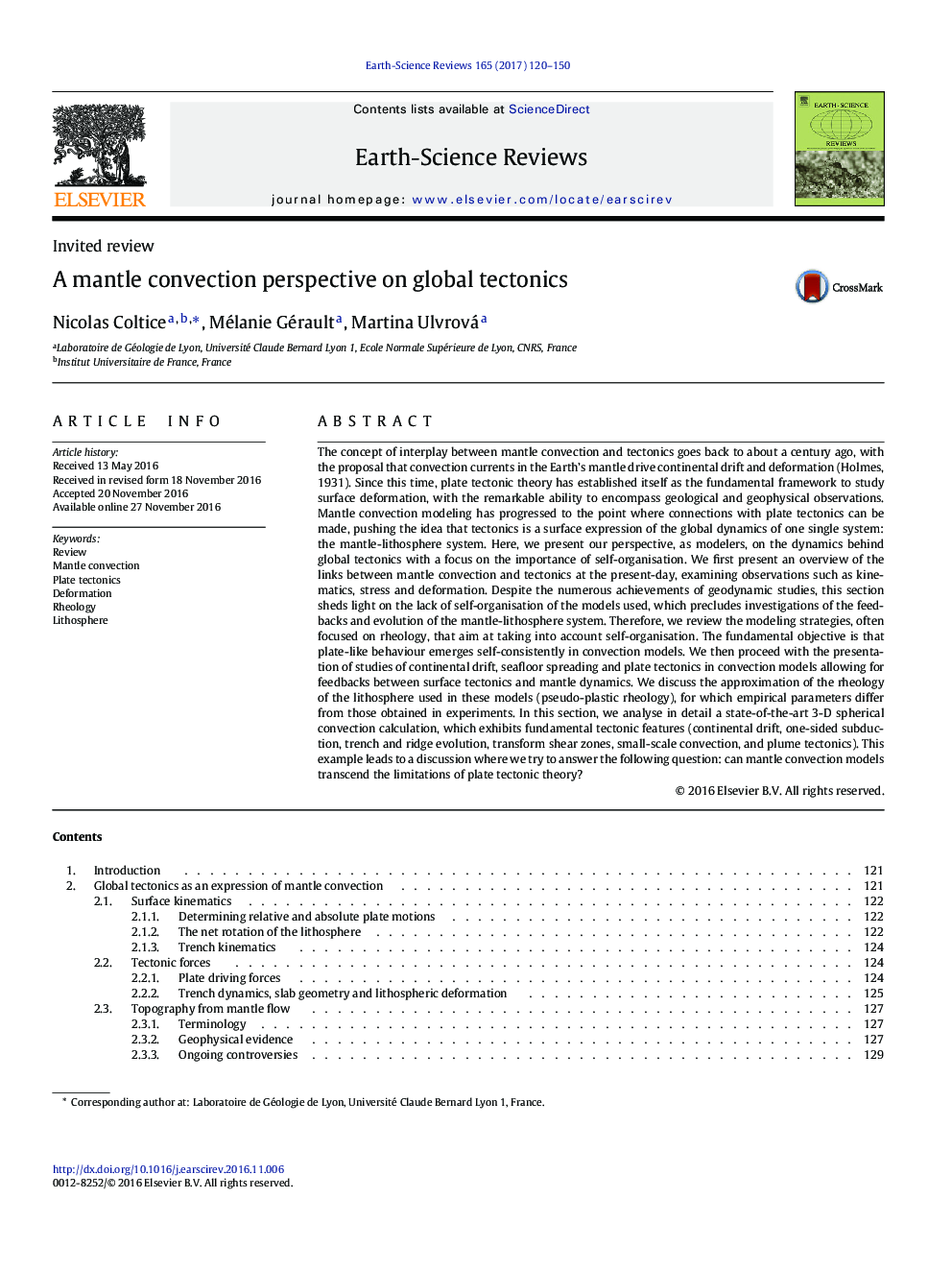| کد مقاله | کد نشریه | سال انتشار | مقاله انگلیسی | نسخه تمام متن |
|---|---|---|---|---|
| 5785138 | 1639937 | 2017 | 31 صفحه PDF | دانلود رایگان |
عنوان انگلیسی مقاله ISI
A mantle convection perspective on global tectonics
ترجمه فارسی عنوان
دیدگاه کانکور گوشته در تکتونیک جهانی
دانلود مقاله + سفارش ترجمه
دانلود مقاله ISI انگلیسی
رایگان برای ایرانیان
کلمات کلیدی
مرور، کنسانتره مانت، تکتونیک صفحات، تغییر شکل، رئوئولوژی، لیتوسفر،
ترجمه چکیده
مفهوم اثر متقابل بین کنجکاوی گوشته و زمین شناسی، حدود یک قرن پیش، با پیش بینی جریانات کنسانتره در چرخش قاره زمین و تغییر شکل (هولمز، 1931)، باعث شده است که گرانش زمین. از آن زمان به بعد، تئوری تکتونیکی صفحات خود را به عنوان چارچوب اساسی برای مطالعه تغییر شکل سطح، با توانایی قابل توجهی برای بررسی مشاهدات زمین شناسی و ژئوفیزیکی تاسیس کرده است. مدل سازی کنجکاوی مگس به نقطه ای که ارتباطات با تکتونیک صفحات را می توان انجام داد، پیشرفت کرده است، و این ایده را مطرح می کند که تکتونیک بیان سطحی از پویایی جهانی یک سیستم واحد است: سیستم گوشته و لیتوفان. در اینجا ما چشم انداز خود را، به عنوان مدل سازان، در دینامیک زمین شناسی جهانی با تمرکز بر اهمیت سازماندهی خود ارائه می کنیم. برای اولین بار، در حال حاضر بررسی کلی پیوندهای بین کنجکاوی مانت و تکتونیک در حال بررسی مشاهدات مانند سینماتیک، استرس و تغییر شکل داده شده است. با وجود دستاوردهای متعدد در مطالعات ژئودینامیک، این بخش کمبود خودخواهی از مدل های استفاده شده را نادیده می گیرد، که مانع بررسی بازخورد و تکامل سیستم گوشته و لیتوسفر می شود. بنابراین، ما استراتژی های مدل سازی را مرور می کنیم که غالبا بر روی رئوئولوژی تمرکز می کنند و هدف آنها در نظر گرفتن خود سازمانی است. هدف اصلی این است که رفتار پلاستیکی به صورت خودمختار در مدل های کنترلی ظاهر می شود. پس از آن ما ارائه مطالعات رانش قاره ای، گسترش دریایی و تکتونیک صفحات را در مدل های کنجکاو ارائه می دهد که اجازه می دهد تا بازخورد بین تکتونیک سطح و پویایی مانت. ما در مورد تقریب شناسی لیتوفسفری مورد استفاده در این مدل ها (ریاضی شبه پلاستیک) بحث می کنیم، برای آن پارامترهای تجربی از آنچه که در آزمایش ها به دست آمده است متفاوت است. در این بخش، ما به طور دقیق محاسبه کروی کروی پیشرفته 3 بعدی، که ویژگی های اصلی تکتونیکی (رانش قاره ای، فرورفتگی یکطرفه، تکانه ترانشه و رگه، تکانه های برشی، ، و تکتونیک های رسیده). این مثال منجر به بحث و گفتگو می شود که ما سعی می کنیم به سوال زیر پاسخ دهیم: آیا می توان مدل های کنجکاوی مداد را فراتر از محدودیت های نظریه تکتونیک صفحات دانست؟
موضوعات مرتبط
مهندسی و علوم پایه
علوم زمین و سیارات
زمین شناسی
چکیده انگلیسی
The concept of interplay between mantle convection and tectonics goes back to about a century ago, with the proposal that convection currents in the Earth's mantle drive continental drift and deformation (Holmes, 1931). Since this time, plate tectonic theory has established itself as the fundamental framework to study surface deformation, with the remarkable ability to encompass geological and geophysical observations. Mantle convection modeling has progressed to the point where connections with plate tectonics can be made, pushing the idea that tectonics is a surface expression of the global dynamics of one single system: the mantle-lithosphere system. Here, we present our perspective, as modelers, on the dynamics behind global tectonics with a focus on the importance of self-organisation. We first present an overview of the links between mantle convection and tectonics at the present-day, examining observations such as kinematics, stress and deformation. Despite the numerous achievements of geodynamic studies, this section sheds light on the lack of self-organisation of the models used, which precludes investigations of the feedbacks and evolution of the mantle-lithosphere system. Therefore, we review the modeling strategies, often focused on rheology, that aim at taking into account self-organisation. The fundamental objective is that plate-like behaviour emerges self-consistently in convection models. We then proceed with the presentation of studies of continental drift, seafloor spreading and plate tectonics in convection models allowing for feedbacks between surface tectonics and mantle dynamics. We discuss the approximation of the rheology of the lithosphere used in these models (pseudo-plastic rheology), for which empirical parameters differ from those obtained in experiments. In this section, we analyse in detail a state-of-the-art 3-D spherical convection calculation, which exhibits fundamental tectonic features (continental drift, one-sided subduction, trench and ridge evolution, transform shear zones, small-scale convection, and plume tectonics). This example leads to a discussion where we try to answer the following question: can mantle convection models transcend the limitations of plate tectonic theory?
ناشر
Database: Elsevier - ScienceDirect (ساینس دایرکت)
Journal: Earth-Science Reviews - Volume 165, February 2017, Pages 120-150
Journal: Earth-Science Reviews - Volume 165, February 2017, Pages 120-150
نویسندگان
Nicolas Coltice, Mélanie Gérault, Martina Ulvrová,
